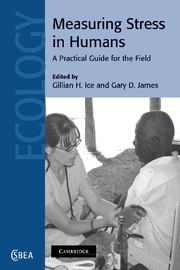Book contents
- Frontmatter
- Contents
- Contributors
- Foreword by Geoffrey A. Harrison
- Part I General principles
- Part II Measuring stress responses
- 2 Cultural dimensions of the stress process: measurement issues in fieldwork
- 3 Measuring emotional and behavioral response
- 4 Measuring hormonal variation in the sympathetic nervous system: catecholamines
- 5 Measuring hormonal variation in the hypothalamic pituitary adrenal (HPA) axis: cortisol
- 6 Measuring physiological changes in the cardiovascular system: ambulatory blood pressure
- 7 Measuring immune function: markers of cell-mediated immunity and inflammation in dried blood spots
- Part III Practical issues in studying stress
- Index
- References
3 - Measuring emotional and behavioral response
Published online by Cambridge University Press: 11 September 2009
- Frontmatter
- Contents
- Contributors
- Foreword by Geoffrey A. Harrison
- Part I General principles
- Part II Measuring stress responses
- 2 Cultural dimensions of the stress process: measurement issues in fieldwork
- 3 Measuring emotional and behavioral response
- 4 Measuring hormonal variation in the sympathetic nervous system: catecholamines
- 5 Measuring hormonal variation in the hypothalamic pituitary adrenal (HPA) axis: cortisol
- 6 Measuring physiological changes in the cardiovascular system: ambulatory blood pressure
- 7 Measuring immune function: markers of cell-mediated immunity and inflammation in dried blood spots
- Part III Practical issues in studying stress
- Index
- References
Summary
Introduction
This chapter aims to review measures of the emotional and behavioral responses to stressors. As reviewed in Chapter 1, there are multiple cognitive responses to a stressor starting with the appraisal of a stressor. After a person appraises a stressor or evaluates it as a threat, s/he will experience a stress response, often including an emotional and behavioral response. For example, an individual is exposed to the stressor of caring for a relative with dementia, s/he may feel burdened, anxious and sad. This same person may engage in various coping behaviors such as smoking or seeking solace at a place of worship. The way that an individual responds to a stressor (from the appraisal through the stress response) depends on various factors (e.g. personality, coping resources) which may mediate or moderate the way in which an individual appraises and then responds to a stressor. For example, this same caregiver, may have a large supportive family which minimizes the appraisal of threat or the emotional response in comparison to an individual without such support. The reader should refer to Chapters 1 and 2 for the definition of the concepts of mediators, moderators, appraisal and behavioral and emotional responses as this chapter will focus on the measurement approaches and will briefly review published measures of such concepts and different measurement approaches. One should note, as discussed in Chapters 1 and 2, that often these cognitive processes are lumped together in a single measure of “perceived stress.”
- Type
- Chapter
- Information
- Measuring Stress in HumansA Practical Guide for the Field, pp. 60 - 93Publisher: Cambridge University PressPrint publication year: 2006
References
- 1
- Cited by

